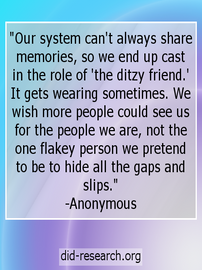.
Effects of Identity Alterations
Identity alteration is the effect of alters on how individuals with dissociative identity disorder (DID) or other specified dissociative disorder, subtype 1 (OSDD-1) perceive themselves and interact with the outside world. Identity alteration is a major factor that differentiates these disorders from other conditions which may involve dissociation, identity confusion, difficulties with memory, or posttraumatic stress. It refers to the manifestations of alters containing and expressing differing opinions, perceptions, and senses of self. At its most extreme, this presents as switching, in which the individual with DID/OSDD-1 may perceive that an entirely different person resides within them and has taken over their behavior or that they've become a different person. The individual may experience, or others may notice, a shift in the individual's preferred name, their sense of how old they are, their gender identity, or their preferences, skills, and memories. Even vocal pitch, body language, and physical reactivity to stress may change. In some cases, the individual may experience time loss or black out amnesia, in which one or more parts of the self are unaware that other parts are acting in their absence. Less drastically, the individual may experience passive influence, in which alters influence the individual's sense of self and behavior without taking full executive control. A similar experience is co-consciousness, in which multiple alters are able to be present and to present their own unique self-views at once. This may lead to conflict between parts, confusion over who one really is, or experiencing internal voices, feelings, or urges that seem to come "out of nowhere" or are ego-alien. Finally, splitting refers to the creation of a new alter and so involves the accommodation of a new identity and sense of self.
For more information, see:
Switching and Passive Influence
Time Loss, Black Outs, and Co-consciousness
Another important source on identity alteration is "The Stranger in the Mirror" by Dr. Marlene Steinberg, the creator of a major tool for diagnosing DID, the SCID-D.
“As an undergraduate student in psychology, I was taught that multiple personalities were a very rare and bizarre disorder. That is all that I was taught on ... It soon became apparent that what I had been taught was simply not true. Not only was I meeting people with multiplicity; these individuals entering my life were normal human beings with much to offer. They were simply people who had endured more than their share of pain in this life and were struggling to make sense of it.”
― Deborah Bray Haddock, The Dissociative Identity Disorder Sourcebook
Image transcript: "Our system can't always share memories, so we end up cast in the role of 'the ditzy friend.' It gets wearing sometimes. We wish more people could see us for the people we are, not the one flakey person we pretend to be to hide all the gaps and slips." The text is attributed to an anonymous DID/OSDD-1 system.

